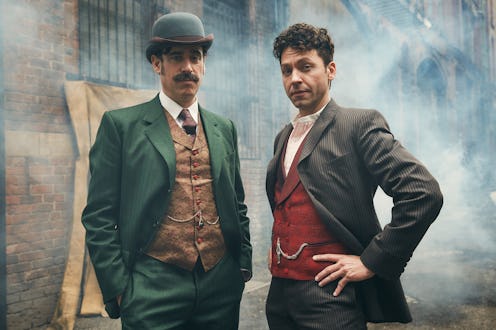
It makes sense that one of the writers of FOX's House would be interested in Sir Arthur Conan Doyle for his next TV project; after all, that popular medical procedural certainly had a few things in common with Doyle's most famous literary creation, Sherlock Holmes. But why did David Hoselton, co-creator of the upcoming FOX drama Houdini & Doyle decide to throw world-famous magician Harry Houdini into the mix? Is this just another pop culture mash-up like Alien vs. Predator or Freddy vs. Jason? Or were Houdini and Doyle really friends?
Sir Arthur Conan Doyle was born in 1859 in Edinburg, Scotland; Harry Houdini (née Erich Weisz) was born in 1874 in Budapest, Austria-Hungary and emigrated to Wisconsin when he was 4. With the Atlantic Ocean and more than a decade separating the two men, a friendship seems highly unlikely; more like a flight of fancy imagined by a creative television writer than the stuff of history. And yet, sometimes truth really is stranger than fiction — because, yes, the magician and the author really did meet and become friends… and, eventually, just the opposite .
This real-life relationship has previously been adapted into a number of novels, films, and stage plays. The reason the friendship between the two men has so long captivated the imagination is because of the fundamental dichotomy of their relationship, which was the very epitome of the "Man Of Science vs. Man Of Faith" trope, as explained by The Guardian. You might assume that the conjurer of illusions was the supernatural devotee and the author of mysteries was the scientific mind; but you'd be wrong. In fact, Houdini was devoted to science and logic, while Doyle believed fervently in a plane beyond our own existence..
According to Biography.com, Doyle was a lifelong adherent to Spiritualism, a movement founded in the 1840s by a trio of women called the Fox sisters who were self-proclaimed psychics. The Fox sisters later admitted their séances were a hoax, but that didn't dampen Doyle's enthusiasm for the supernatural; he joined the British Society for Psychical Research in 1893. After a medium allegedly contacted his son — who had died from wounds sustained in WWI — Doyle devoted himself entirely to the movement, publishing several books inspired by these beliefs, such as The Land Of Mist and The Coming Of The Fairies .
Meanwhile, Houdini entertained a brief flirtation with the supernatural, according to Biography, attending several séances after the sudden death of his beloved mother; but, himself being a fellow magician, he could see right through the tricks the mediums employed. He subsequently devoted himself to exposing the charlatans for what they were: "human leeches," as The Guardian recounts. He wrote a book called The Unmasking Of Robert-Houdin , in which he accused his own personal idol of being a fraud; Harry Houdini brazenly sent a copy of this book to knighted author and defender Spiritualism, Sir Arthur Conan Doyle… and so their relationship began.
You might think that Doyle would be affronted by Houdini's presumption, but he was actually grateful: "He felt that Houdini was rooting out the rotten mediums so that the mediums with true ability could thrive," Biography.com explains. Intrigued by the younger magician, Doyle caught one of Houdini's shows while he was touring through Europe in 1920 and — impressed by his ability to seemingly dematerialize — was convinced that Houdini himself was one of the "true" mediums he so desperately sought. (In a catch-22, Houdini was unable to dissuade Doyle from this belief since the "magician's code" prevented him from revealing the secrets to any of his tricks.)
Despite their wildly different belief systems, the two men respected each other and struck up a friendship, corresponding back and forth quite frequently over a period of a couple of years. However, that all changed forever one night in 1922, according to The Guardian. Over the years, Doyle's wife Jean had become convinced that she herself was a medium; that fateful night, the Doyles invited Houdini to their hotel room in Atlantic City to conduct a séance in an attempt to contact Houdini's departed mother. Although Jean filled 15 pages of writing with supposed messages from the grave, Houdini didn't believe it was his mother: the message began with an image of a cross while Houdini's mother was Jewish, and it was written in fluent English, while his mother barely spoke the language. "The relationship barely survived that incident," The Guardian wrote.
Biography.com also reveals that, shortly after, Houdini published an article in the New York Sun in which he stated that he had never met a medium that passed muster; Doyle took this as a direct reference to his own wife, and the friendship between the two men was ended. The dissolution of their relationship was chronicled in a series of "sharp letters" published back and forth in the New York Times, according to PBS, in which Doyle referred to Houdini as "biased and publicity hungry" and the magician said of the author, "There is nothing that Sir Arthur will believe that surprises me." It all finally culminated in a "public feud" when their respective tours happened to coincide in Denver, Colorado.
Given that their friendship only lasted two years or so — and mostly existed via the postal service — it's unlikely that the two men ever solved crimes together in turn-of-the-century London, as their fictional counterparts do in FOX's Houdini & Doyle. But the relationship between the two men was so complicated and fascinating that it's not hard to see why it has continued to intrigue almost a century after its sudden — and perhaps inevitable — collapse.
Images: FOX, Robert Vigliasky/FOX